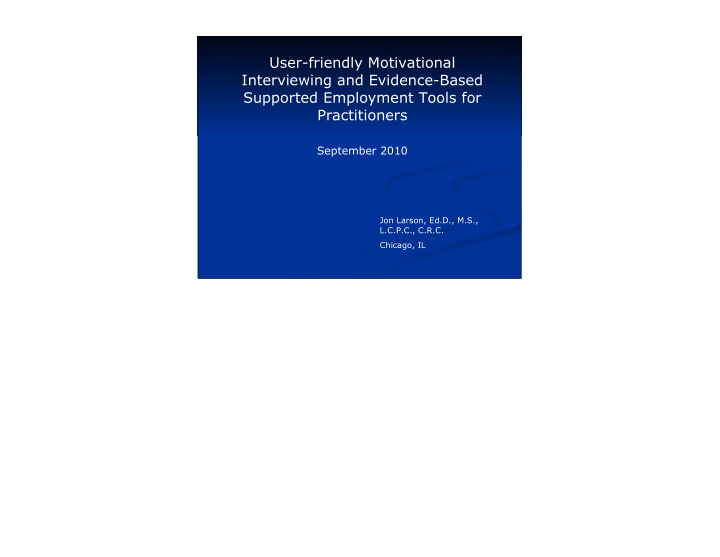



User-friendly Motivational Interviewing and Evidence-Based Supported Employment Tools for Practitioners September 2010 Jon Larson, Ed.D., M.S., L.C.P.C., C.R.C. Chicago, IL
Overview: Problems reported 2.6% diagnosed with severe mental illness in US. demonstrated as number 1 cause of disability. reported 85-90% unemployment rates. when employed, reported shorter job retention rates than general public. (The Substance Abuse and Mental Health Services Administration, 1993; The World Health Organization, 2002; Anthony, Cohen, Farkas, and Gagne, 2002; Bricout, 2002; National Alliance for the Mentally Ill, 2004)
Overview: Problems demonstrated over 70% rely on Social Security programs with annual income less than $15,000. found high rates of entry level positions. reported minimal job advancement opportunities. (Hall, Graf, Fitzpatrick, Lane, and Birkel, 2003; U.S. General Accounting Office, 1996)
Problem 90% unemployment rates 50% employment rates for participants in high fidelity evidence-based supported employment programs (Bond, Drake, Becker, 2008)
Overview: Good News individuals with SMI want to work and consider employment important in recovery. employment reduces poverty. work increases self-esteem. important in psychological and social well being. (Cook & Picket, 1995; Crowther, Marshall, Bond, & Huxley, 2001; McQuilken, et al., 2003; Mueser, Salyers, & Mueser, 2001; Rogers, 1995; Rogers, Walsh, Masotta, & Danley, 1991; Steele & Berman, 2001; Arns & Linney, 1995; Bricout, 2002; Lehman, et al., 2002; Mueser et al., 1997; Polack & Warner, 1996)
Overview: Good News reduces financial strain on government programs. defines self-identity. provides economic resources. builds social connections. improves quality of life. (Baron, 2000; Drake, McHugo, Becker, Anthony, & Clark, 1996; Kouzis & Eaton, 2000; Polak & Warner, 1996; The National Institute on Disability and Rehabilitation Research, 2005)
Overview: Solutions Numerous studies reported individuals with SMI have been successful in employment. Individual Placement and Support (IPS) employment model demonstrated the best evidence to increase employment rates. 40-60% IPS participants obtained employment. Motivational Interviewing helps individuals prepare to change employment behaviors. (Becker and Drake, 1993, 2003; Bond, 1992; Bond, 2004; Bond, Becker, Drake, Rapp, Meisler, & Lehman, 2001; Bond, Drake, Becker & Mueser, 1999; Cook, Leff, et al., 2005; Cook, Lehman, et al., 2005; Cook & Razzano, 2000; Crowther, Marshall, Bond, & Huxley, 2001; Honey, 2000; Lehman, 1995; Rogers, Anthony, Toole, & Brown, 1991; Miller & Rollnick, 2002; Schneider, Heyman & Turton, 2002)
Evidence-Based Supported Employment Model EBSE Principles: Competitive employment is the goal Rapid job search Integration of rehabilitation and mental health Attention to consumer preferences Continuous and comprehensive assessment Time-unlimited support Benefits Planning (Bond, 1998)
Phase 1 Study Examined the impact of an Individual Placement and Support enhanced with Motivational Interviewing. Increase stages of change to increase jobs offered, jobs obtained, and hourly wage. Increase job leads from employment specialists to increase job interviews and job offers. Increase clients telephoning potential employers to increase job interviews and job offers.
Phase 1 Study Process and Outcome Analysis of a Supported Employment Program for People with Psychiatric Disabilities. (Larson, Barr, Kuwabara, Boyle, Glenn, 2007). Feasible to combine Evidence Supported Employment and Motivational Interviewing Job variables significantly improved Job variables related to Stages of Change Phase 2 Study User-Friendly Motivational Interviewing and Evidence-Based
Phase 3 Study Perspectives on Benefits and Costs of Work from Individuals with Psychiatric Disabilities. (Larson, Barr, Kuwabara, Boyle, Glenn, 2007). Found 47 distinct themes related to costs and benefits to employment Phase 4 Study Analyses of an Employment Commitment Measure for Individuals for Psychiatric Disabilities. (Larson, Goldsmith, Wassel, Kaszynski, Ibara, Glenn, Boyle, In Review).
ECM11 Factor 1: Incentive Increase Responsibility 1. Reduce Anxiety 2. Increase Problem Solving 3. Show People the Ability to Handle Stress 4. Reduce Depression 5.
ECM11 Factor 2: Barrier Disclose Criminal Record 1. Lose Government Benefits 2. Experience Discrimination 3. Require Drug Screening 4. Increase Stress 5. Lose Free Time 6.
Summary of Findings Incentive Factor predicts employment status. (Hypothesis 1) Employment commitment contains an Incentive Factor and a Barrier Factor. (Hypothesis 2) Barrier Factor does NOT add to the prediction of employment status. Age, gender, education, ethnicity, housing, mental health tenure, and agency tenure do NOT add to the prediction of employment status.
Resources Miller, W.R., & Rollnick, S. (2002). MI: Preparing people for change. New York: Guilford Press. Larson. J.E. (2008). User-Friendly Motivational Interviewing and Evidence- Based Supported Employment Tools for Employment Practitioners. Journal of Rehabilitation, 74 (4).
Resources Becker, D.R., & Drake, R.E. (2003). A working life: The individual placement and support program. Oxford, England: Oxford University Press. Bissonnette, D. (1994). Beyond traditional job development.
Resources Substance Abuse and Mental Health Services Administration Supported Employment Tool Kit. Found at: http://mentalhealth.samhsa.gov/cmhs/ communitysupport/toolkits/employment/ The Promise of Evidence-Based Practices and Recovery for Persons with Severe Mental Illness: Perspectives for Rehabilitation Professionals, Chapter 3. The 33 rd Institute of Rehabilitation Issues. Office of Special Education and Rehabilitation Services. (2008).
IPSMI Intervention Framework Stage of Change Intervention Outcome Pre-contemplation Motivational Int. Move to contemplation Contemplation Motivational Int. Move to determination Determination IPS Set job goals Action IPS Locate job Maintenance IPS Maintain job Relapse Motivational Int. Move to earlier Problem-solve stage
Motivational Interviewing Enhancement technique for behavioral change through identifying and resolving ambivalence and discrepancies between verbal and behavioral actions. costs/benefits analysis discuss the readiness ruler engage with active listening promote change talk avoid arguments ask for permission (Miller & Rollnick, 2002)
Motivational Interviewing Five Early Strategies Ask open-ended questions Listen reflectively Affirm Summarize Elicit self-motivational statements What are these?: problem recognition, expression of concern, intention to change, optimism about change
Five Basic Principles of Motivational Interviewing Express empathy Develop discrepancy Avoid argumentation Roll with resistance Support self-efficacy
Motivational Interviewing Skills Appendix A: Stages of Change Interview for Employment Appendix B: Stages of Change Interview for Behaviors Appendix C: Roadblocking
Motivational Interviewing Skills Appendix D: Active Listening Appendix E: Costs Benefits Appendix F: Ready, Able, Willing, Resources Ruler Appendix H: MI Fidelity
EBSE placement and follow up skills Appendix I: Job Plan Appendix J: Job Skills Appendix K: Employment Questionnaire
Recommend
More recommend